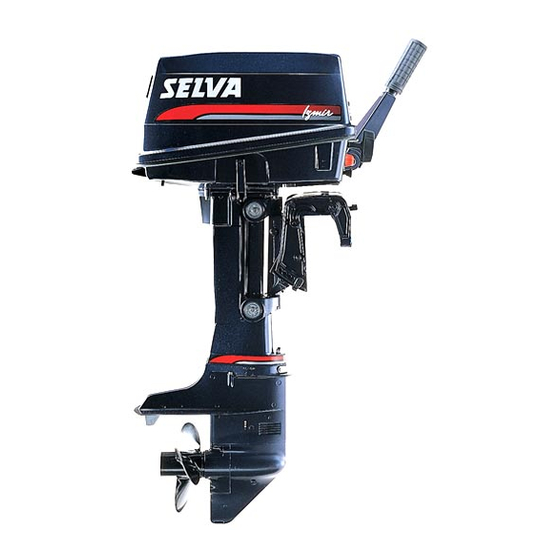
Table of Contents
Advertisement
Advertisement
Table of Contents

Summarization of Contents
INTRODUCTION
Directions for use. Basic safety measures.
Read the manual carefully and pay attention to safety rules for safe operation.
ATTENTION
Explanation of symbols used in the manual to highlight important information and warnings.
OUTBOARD MOTOR IDENTIFICATION DATA
SERIAL NUMBER RECORD
Space to record your outboard motor's serial number for future reference.
Data Verification
Ensure the data on the label matches your registration book.
Horsepower Limit
Warning against installing motors with horsepower exceeding boat certification.
DIRECTIONS FOR USE
Basic Safety Measures
Essential safety guidelines for operating the outboard motor, including legal requisites and personal condition.
Fuel and Oil Usage
Instructions on using appropriate fuels and oils and checking levels regularly.
Maintenance Safety
Precautions to take before performing maintenance or cleaning procedures.
Cowling Safety
Guidelines for opening the top cowling, ensuring the engine has cooled down.
PAY ATTENTION TO THE PROPELLER
Propeller Safety Zone
Keep clear of the rotating propeller to avoid contact and injury.
Kill Switch Lanyard Use
Attach the engine stop switch lanyard to the wrist when the motor is on.
Safe Motor Operation Practices
Guidelines on motor use, steering rod, and keeping the cowling on.
Tilt-Up and Locking Mechanisms
Instructions on tilting the motor out of the water and engaging the free-lock lever.
Electrical and Fuel Safety
Precautions with electrical parts, spark plugs, and fuel tank safety.
OPERATIONAL SAFETY AND MAINTENANCE
Post-Accident and Modification Safety
Procedures after an accident and warnings about unauthorized modifications.
Safe Operation Practices
Includes fire prevention, avoiding dangerous manoeuvres, and following regulations.
Weather and Route Planning
Emphasizes checking weather and informing about route for safe sailing.
CONTROL FUNCTIONS
Starting, Stopping, and Gear Shifting
Covers gear shift, stop buttons, choke, starter handle, and switch key.
Throttle, Steering, and Trim Controls
Includes throttle adjustment, steering handle, and trim angle adjustment rod.
Mounting and Locking Mechanisms
Covers cowling locks, free-lock mechanism, clamp screws, and tilt-up lever.
Wiring diagram.
Model with manual start
Wiring diagram and legend for models with manual engine starting.
Model with electric start
Wiring diagram and legend for models with electric engine starting.
THE USE OF OUTBOARD MOTOR
PRELIMINARY CONTROLS CHART
Checklist of essential items and procedures before operating the motor.
Safety Warning
Importance of pre-operation checks for safety and functionality.
Check of the supply.
Outboard motor mounting.
Guidance on proper motor positioning on the transom for optimal performance and height.
Mounting Height Impact
Explains consequences of incorrect mounting height (cavitation, drag).
Transom Support
Ensuring the bracket is fully supported or using wood blocks for stability.
Trim angle adjusting
Optimal Trim Angle and Impact
Importance of trim angle for performance, control, and stability.
Procedure for Trim Adjustment
Step-by-step guide to adjust the trim angle, including locking mechanisms.
Pre-Adjustment Checks
Ensure engine is off and clamp screws are tight before adjusting trim.
BATTERY MOUNTING
Connecting the Battery
Procedure for connecting and disconnecting battery leads safely.
Battery Handling Safety
Precautions for handling battery fluid and avoiding hazards like explosion.
Recommended Battery Type
Specifies the recommended battery type for the motor.
FUEL
Preparation of the Fuel
Instructions for preparing the correct fuel mixture with oil.
Fuel Tank and Pipe Connection
Guidance on connecting fuel tank lines and ensuring secure connections.
Fuel Safety Precautions
Safety warnings related to fuel handling, refuelling, and spills.
STARTING PROCEDURES
Pre-Start Checks
Essential checks before starting the engine for safe operation.
Cold Start Methods
Detailed steps for starting a cold engine (manual and electric).
Post-Start Verification
Checks to ensure the engine is running correctly after starting.
CRUISING
Navigation Responsibility
Operator's responsibility for boat and passenger safety during navigation.
Motor Tilt-Up Procedure
Procedure for tilting the motor up and returning it to cruising position.
Overheat Warning and Response
How to respond to the overheat warning and what checks to perform.
Start-in-Gear Protection Feature
Feature preventing engine start unless in neutral.
OPERATIONAL PROCEDURES
Emergency Starting
Using the emergency starter rope with safety precautions.
Running-In the Motor
Guidelines for the initial running hours to ensure proper performance.
Stopping Procedures
Steps for emergency and normal engine stopping.
STORAGE AND CLEANING
Long-Term Storage Preparation
Steps to stop the engine and prepare for extended periods of non-use.
Motor Removal and Cleaning
Procedure for removing the motor and cleaning its exterior and passages.
MAINTENANCE
Pre-Maintenance Safety
Safety precautions before performing any maintenance or check operation.
Maintenance Operations Overview
Lists periodic maintenance operations and identifies those requiring qualified staff.
Greasing and additions
Gearbox-Oil Change
Procedure for changing the gearbox oil, including level checks and quantity.
Spark Plug Inspection and Replacement
Guidance on inspecting, cleaning, and replacing spark plugs for optimal performance.
COMPONENT MAINTENANCE AND HANDLING
Sacrificial Anode Maintenance
Instructions for cleaning and replacing the sacrificial anode to prevent corrosion.
Propeller Replacement
Importance of propeller choice and procedure for replacement.
Towing Guidelines
Correct method for towing the motor, avoiding tilt-support lever use alone.
Storage
Motor Storage Procedures
Steps for preparing the motor for long-term storage, including cleaning and oiling.
Fuel Tank Storage
Guidelines for storing the fuel tank in a ventilated area.
Battery Storage
Instructions for storing the battery safely during long periods.
TROUBLESHOOTING
Common Difficulties and Causes Chart
A chart listing common problems and their potential causes.



Need help?
Do you have a question about the Naxos and is the answer not in the manual?
Questions and answers